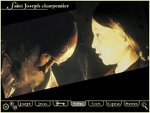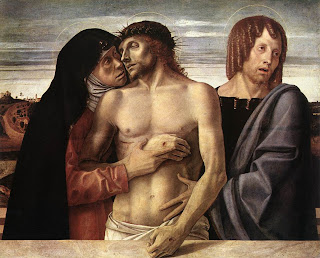Giovanni Bellini (1426-1516) was a painter from Venice and can be considered as the founder of the Venetian school of painting. Under his influence Venice became a center of Renaissance art that rivaled Florence and Rome. He brought to painting a new degree of realism, a new wealth of subject-matter, and a new sensuousness in form and color. This made him become one of the early masters in the techniques of oil painting. Albrecht Durer himself recognized that "he is the best painter of them all."
His pictures combine a severe and rigid style with a depth of religious feeling and gentle humanity, as the following pictures show. It is a pieta painted in 1460

One of the artist's most complete and programmatical figurative works. On the parapet on which Christ is held by the Madonna and St. John is the inscription:
HAEC FERE QUUM GEMITUS TURGENTIA LUMINA PROMANT: BELLINI POTERAT FLERE IOANNIS OPUS (When these swelling eyes evoke groans, this work of Giovanni Bellini could shed tears).
This is a fragment of a hymn from the first book of Propertius's "Elegies", whose presence at the base of the painting affirms the artist's religious education.
The Pietà is rightly considered one of the most moving paintings in the history of art. Deep feeling is expressed throughout, from the landscape that recalls Flemish antecedents to the lucid architectonic composition of the group and the abstract geometry of their movements, deriving from Piero della Francesca. A passionate feeling that is not so much religious as human and psychological pervades the actors in the drama. The rendering of grief has here its most universal expression and, at the same time, its most private and conscious dimension. The mother's pathetic gesture is reflected in St John's turning away. The construction of the work shows careful thought. The figures, borrowed from popular imagery, are grouped in the foreground against an infinite horizon. The pentagonal arm of Christ ending in a closed fist is that of a fallen but un vanquished athlete. The barely glimpsed landscape, with its road wandering up a height and its torrent coursing below, pulsates with earthly life.
The figures stand out against a leaden dreamlike sky. The painting retains a strong Paduan element that is evident in the contours, adjusting gestures and figures to the strong expressive requirements of the drama. The silent exchange of emotions in the faces is reflected in the masterly play of the hands. The landscape behind them, empty and metallic in the cold, shining greys of the painful dawn of rebirth, accentuates the sense of the scene's anguish. Both the Donatello of the altar of St Anthony of Padua and, once again, Mantegna and the Flemish masters are the influences which spurred Bellini along the path of a sad and bitter pathos.
(From Web gallery of art)




